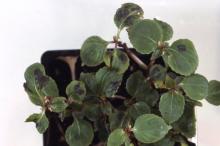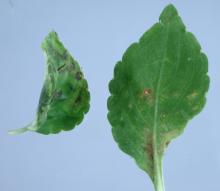See:
Greenhouse Plants, Ornamental - Impatiens Necrotic Spot
Cause Impatiens necrotic spot virus (INSV), formerly the I strain of the tomato spotted wilt virus (TSWV-L). The INSV has been reported on many floral crops. Unlike TSWV, which has many thrips vector species, INSV is reported to be vectored only by the western flower thrips, Franklinella occidentalis. Double-flower impatiens are highly attractive to the thrips vector and often show dramatic symptoms of INSV infection. TSWV infection is less common, and symptoms are similar. Both viruses can infect impatiens.
Symptoms Symptoms of INSV on New Guinea impatiens include stunting, brown or purple leaf spots, ringspots on petals, black diffuse spotting on leaves, black stem sections, leaf stunting, distortion, and chlorotic mottling. Multiple necrotic spots may be seen rather than a single spot (which is more typical of a fungal infection). Leaf blights may start at the base of the leaf and become blackened. Plants may wilt and collapse. Variation is extreme from cultivar to cultivar, and many cultivars are symptomless. Symptoms may appear in winter and be masked in summer. Symptoms caused by TSWV are indistinguishable.
Symptoms of INSV on single- and double-flowered I. wallerana include yellow mosaic, scattered small black or brown spots or flecks, brown or black ringspots often preceding leaf yellowing and abscission, black stem sections, and stunting of the leaf and plant.
Sampling Test kits are available for initial disease diagnosis.
Cultural control
- Have suspected diseased plants tested for virus.
- If the virus is present, destroy all infected plants and remove them and their potting soil (which contains the thrips' pupae) from the greenhouse range.
- Use light blue or yellow sticky traps to monitor thrips. Place one (1) sticky trap per 500 to 1,000 sq ft just above plants. Check traps weekly and keep accurate records of when and where thrips are trapped.
- Remove weeds under benches. Bittercress, for example, is attractive to thrips and is a symptomless carrier of the virus.
- Place indicator plants in each house where thrips may land. A number of petunia cultivars including Calypso, Summer Madness, and Super Blue Magic are good INSV and TSWV indicators. The fava bean 'Toto' also can be used.
- Separate greenhouse ranges with plastic barriers. Screen or net air intake vents. Use double-entry door construction.
- Workers should avoid wearing light-color clothing such as yellow, blue, and white.
Chemical control Sticky traps and spot treatments are part of an integrated control monitoring program. Consult the PNW Insect Management Handbook for currently effective materials.
Reference Geman, T.L., Ullman, D.E., and Moyer., J.W. 1992. Tospoviruses: Diagnosis, molecular biology, phylogeny, and vector relationships. Annual Review of Phytopathology 30:315-348.



